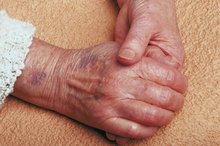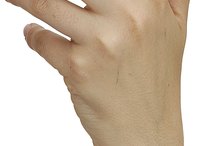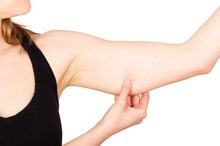What does fact checked mean?
At Healthfully, we strive to deliver objective content that is accurate and up-to-date. Our team periodically reviews articles in order to ensure content quality. The sources cited below consist of evidence from peer-reviewed journals, prominent medical organizations, academic associations, and government data.
The information contained on this site is for informational purposes only, and should not be used as a substitute for the advice of a professional health care provider. Please check with the appropriate physician regarding health questions and concerns. Although we strive to deliver accurate and up-to-date information, no guarantee to that effect is made.
Thinning Skin on the Hands
Many women go to great lengths to keep the skin on their faces looking youthful, while neglecting their hands. It is easy to forget that the appearance of thin skin on your hands can give away your age. Although a certain amount of thinning of the skin on the hands in inevitable as you grow older, there are things you can do to keep your hands looking and feeling their best.
Effects of Aging
The natural aging process contributes to thinning skin. A young person’s skin contains abundant collagen and elastin, the substances which give skin resiliency and strength. Young skin also produces its own hyaluronic acid, a natural sugar complex which traps and holds moisture, giving skin a plump and supple appearance. As you age, your body decreases production of these substances, leaving the skin on the hands looking fragile and thin.
- The natural aging process contributes to thinning skin.
- A young person’s skin contains abundant collagen and elastin, the substances which give skin resiliency and strength.
Sun Exposure
How to Tighten the Skin on Your Hands
Learn More
Long-term exposure to the ultraviolet rays of the sun hastens the depletion of the skin’s collagen. Too much sun also causes a condition called elastosis, in which the skin’s elastin is altered and broken.The hands are nearly always exposed outdoors, and even those people who use sunscreen on their faces often forget to protect their hands. As a result, the skin on the hands is often the first place where people notice thinning skin. Excess sun exposure may eventually leave the hands looking wrinkled and skeletal.
- Long-term exposure to the ultraviolet rays of the sun hastens the depletion of the skin’s collagen.
- Too much sun also causes a condition called elastosis, in which the skin’s elastin is altered and broken.
Medications or Medical Conditions
Certain medications, including oral or topical corticosteroids, can weaken the skin and the blood vessels, causing fragility of the skin on the hands and elsewhere. Thinning skin caused by corticosteroids is reversible, and the skin recovers as soon as medication use stops. Thinning skin can also be caused by medical conditions such as Ehlers-Danlos syndrome and bleeding disorders 3.
Home Care and Protection
Damaged Thin Skin
Learn More
Protect thinning skin by avoiding too much sun exposure and applying a broad-spectrum sunscreen to all exposed skin, including your hands, before heading outdoors. Thin skin is fragile and easily bruised or torn. Since dry skin is more susceptible to damage, it is important to keep the hands moisturized at all times, using a thick cream. The Dermatology Blog recommends that people with thin skin consume a diet high in lean protein and take in sufficient calories to maintain the body’s healing capacity when a skin tear does occur.
- Protect thinning skin by avoiding too much sun exposure and applying a broad-spectrum sunscreen to all exposed skin, including your hands, before heading outdoors.
- Since dry skin is more susceptible to damage, it is important to keep the hands moisturized at all times, using a thick cream.
Professional Treatment
Dermatologists can provide cosmetic treatment to improve the appearance of hands affected by thinning skin. Injections of the dermal fillers Restylane or Perlane, or of the collagen stimulator Sculptra, cost between $500 and $3,000 as of 2010, and can add a “buffer” layer between the skin and the tendons and bones of the hand. The results are only temporary, lasting between six and 24 months. Doctors can also plump up the skin on the hand through the use of fat harvested from a patient’s abdomen, thighs or buttocks. Such injections cost between $1,200 and $5,000 and last from two to five years, although they are more invasive and results are less predictable than with other skin fillers, according to MSNBC.com.
- Dermatologists can provide cosmetic treatment to improve the appearance of hands affected by thinning skin.
- Injections of the dermal fillers Restylane or Perlane, or of the collagen stimulator Sculptra, cost between $500 and $3,000 as of 2010, and can add a “buffer” layer between the skin and the tendons and bones of the hand.
Related Articles
References
- Cleveland Clinic: Aging Skin/ Painful Skin
- MSNBC.com: Turning Back the "Creepy Old Hands" of Time
- Genetics Home Reference: Ehlers-Danlos Syndrome
- Draelos ZD. "Facial Skin Care Products and Cosmetics." Clinics in Dermatology. 2014 Nov-Dec;32(6):809-12.
- Griffith JL, McCowan NK. "Basic Skin Care: A Pragmatic Approach to Better Skin Using Over-the-Counter Cosmeceuticals." Journal of the Mississippi State Medical Association. 2014 Oct;55(10):316-20.
- Tan KW, Graf BA, Mitra SR, Stephen ID. "Daily Consumption of a Fruit and Vegetable Smoothie Alters Facial Skin Color." PLoS One. 2015 Jul 17;10(7):e0133445.
Writer Bio
Gwen Bruno has been a full-time freelance writer since 2009, with her gardening-related articles appearing on DavesGarden. She is a former teacher and librarian, and she holds a bachelor's degree in education from Augustana College and master's degrees in education and library science from North Park University and the University of Wisconsin.









